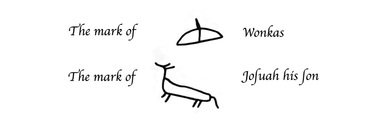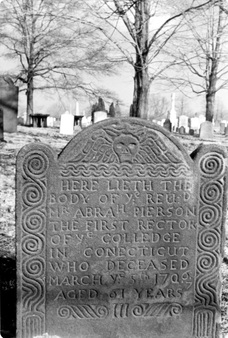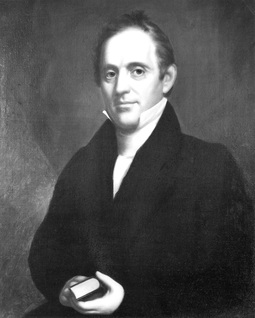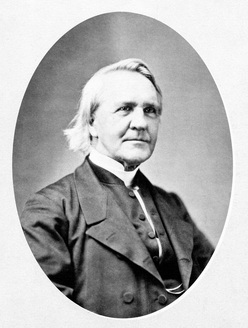The History of Killingworth, Connecticut (continued)
 Marks of Uncas (Wonkas) and his son, Joshuah.
Marks of Uncas (Wonkas) and his son, Joshuah.
At the time of settlement, the Native Americans in this region were the Hammonassets who lived along the shore between the Aigicomock, now East River, and the Connecticut River. They were a peaceful tribe and left behind their burial grounds and large mounds of shells. The name of their Sachem was Sebaquaneh or “the man that weeps.” Uncas, Sachem of the Mohegan, married his daughter and came into possession of the lands of the Hammonassets. On the 26th of November, 1669, Uncas, with Joshuah, his son, sold to the inhabitants of Killingworth all the lands in the township, which he had not sold before to George Fenwick, Esq. of Saybrook. They reserved for themselves “Six acres of Land on the Great Hammock.”
 Gravestone of Abraham Pierson, first Rector of the Collegiate School
(Indian River Cemetery, Clinton, CT).
Gravestone of Abraham Pierson, first Rector of the Collegiate School
(Indian River Cemetery, Clinton, CT).
The town grew slowly at first. In 1686, there were 36 persons (freemen only were counted) living in town and a list of 2412 pounds. In 1694, the Rev. Abraham Pierson was called as pastor. In 1701, he became the first Rector or President of the Collegiate School, later Yale College, and held classes at his house in Killingworth. By 1706, there were 63 persons and a list of 3391 pounds. The Rev. Jared Eliot, one of Pierson’s pupils and a graduate of the Collegiate School in 1706, preached for about two years and was called as pastor and ordained in 1709. He was a distinguished physician and scientist and operated an iron forge off Ironworks Road in present Killingworth, an important forge in colonial times.
The descendants of many of the original settlers began moving to the northern part of the town after 1700. On several occasions, the Town of Saybrook made claims on land in Killingworth. The dispute was finally settled in 1684 when 31 Killingworth planters paid Saybrook £30 for “right of soil.” Finally in 1718, a joint committee of the two towns agreed on a straight line dividing the two towns. In October 1703, a patent or act of incorporation was granted by the General Assembly to the proprietors and inhabitants of “Kilinworth” giving them rights to the land and establishing the bounds of the town. In 1733, the first schoolhouse in the northern part of town was built near Wolf Meadow.
In 1734, the northern inhabitants petitioned the General Assembly to form a new ecclesiastical society because of the difficulty in traveling to the south for church services. In 1735, the General Assembly passed an act dividing the town into two societies and stated where the division line would be made. An ecclesiastical society held responsibility within its boundaries for the church, schools, and the burying grounds. A society house was built in 1736 and a meetinghouse completed in 1743. William Seward who graduated from Yale College in 1734 was called as pastor and ordained in 1738. His ministry in Killingworth lasted 44 years until his death in 1782 at the age of 70. The second pastor was the Rev. Henry Ely for whom the Ely house was built in 1783. In 1816, the Second Ecclesiastical Society voted to build a new meetinghouse. The present Congregational Church building was raised in 1817 and completed in 1820. Notable members of the church were Asahel Nettleton, evangelist, and Titus Coan, missionary to the Hawaiian Islands. An Episcopal church building was completed in 1816. The Rev. George B. Gilbert published “Forty Years a Country Preacher” in 1939.
In 1838, an act of the legislature split Killingworth into two towns with the northern society retaining the name Killingworth and the southern society becoming Clinton. The majority of Killingworth residents were farmers although many mills were built on streams and rivers. Population reached a peak in the first part of the nineteenth century but then declined as residents moved westward to better farming land. At the end of the nineteenth century, immigrants from Europe replaced many of the old families who were departing. For the most part, Killingworth was an isolated rural community and was among the last to receive telephone, paved roads, and electricity. Schools were held in one-room schoolhouses until 1948. Population reached a low point of 482 in 1930 but began to increase in the 1950s as people began moving from the cities to the suburbs, aided by the construction of the Connecticut Turnpike. Killingworth was attractive because of its relatively rural atmosphere and fine school system. Population continued to increase greatly with new residential development but has slowed in recent years. Population in 2010 was 6,525.
©2016 Thomas L. Lentz, Municipal Historian
©2016 Thomas L. Lentz, Municipal Historian


